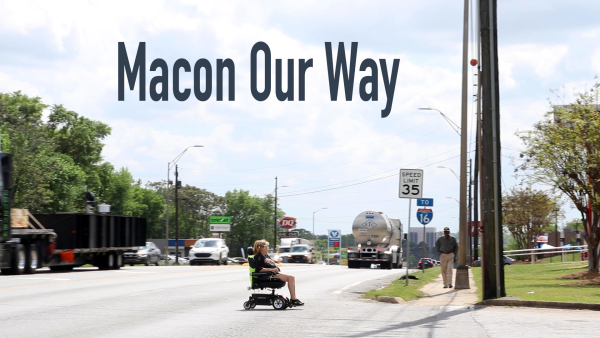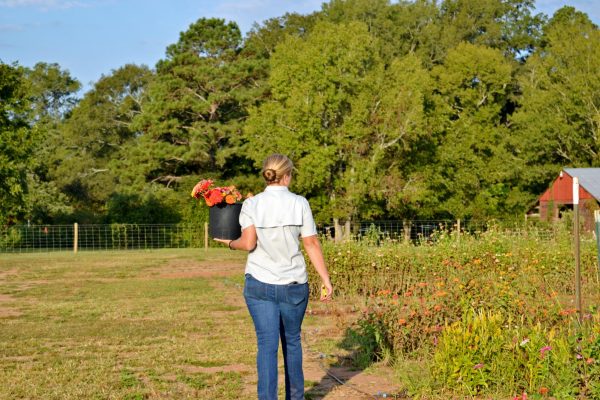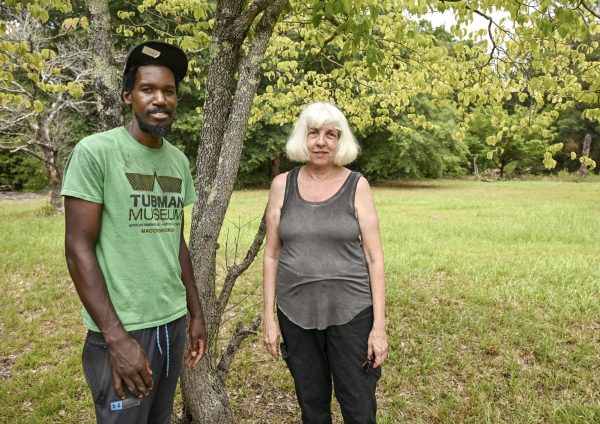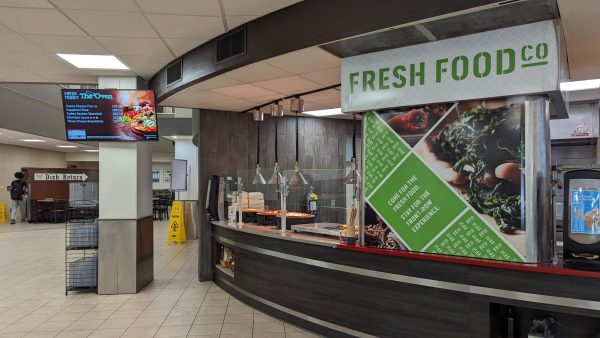“It’s expensive to be poor”
The underlying causes and impact of Macon’s food deserts
The building that once housed the Kroger Supermarket on Pio Nono Ave. lies empty and unused three years after Kroger closed its doors in April 2018.
A store closing in a neighborhood may just lead to another store opening up in its place.
But in April 2018, the Kroger at 400 Pio Nono Ave. closed its doors after serving the community for over 20 years. When that happened, a new store did not open in its place.
Instead, community members in the nearby neighborhood of Napier Heights said they lost access to healthy food.
“It had everything that our community needed to thrive,” Andrea Cooke, a Napier Heights resident and social advocate, said. “Healthy food options — I mean, of course, everybody has their vice when it comes to certain foods, but it was our place to go. It was within walking distance, easily drivable, easily walkable.”
Now, Napier Heights is what experts call a food desert or zone of nutritional scarcity, a neighborhood that lacks easy access to healthy food and groceries. Instead, members of the community without sufficient transportation turn to heavily processed food, which they still have access to in convenience and “Family Dollar” stores.
“If you don’t have access to good food, then your health is impaired,” Cooke said.
Macon’s food desert issue goes beyond Napier Heights. As of 2015, Middle Georgia has 14 census tracts that are classified as food deserts, according to the Department of Agriculture’s Food Access Atlas. Because that is from 2015, those numbers do not even include Napier Heights.
The percentage of the Bibb County population that is in a food desert is 31.9%. According to Atrium/Navicent health, the national average is 22.4%, placing Macon-Bibb County well above the standard.
Even among the “total area” of Middle Georgia that is measured by the study, Macon-Bibb County is one of the worst impacted by food deserts. Middle Georgia has 30.4% of its population living in food deserts in comparison to Macon-Bibb’s 31.9%.
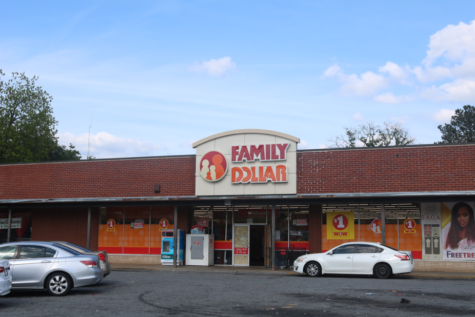
A month-long investigation from a team of students from the Center Collaborative Journalism provides new insight into the food desert issue in Macon.
The CCJ investigation found that the expansion of big-box grocery retailers in Macon — such as Kroger — is linked to a decrease in small, locally-owned grocery stores.
The investigation also looked at research, both Macon-specific and nationally, that shows the impact of food deserts on health. Experts, community members and academic research also ties the food desert issue to transportation, with lack of access to transportation limiting many communities’ ability to get groceries.
But, additionally, there are members of the Macon community who are thinking about how to address food deserts and trying to take concrete steps to bring healthy food back into Macon’s food deserts.
What is a food desert?
The United States Department of Agriculture is the governmental body that determines whether an area is a food desert. To be considered a food desert, an area must meet two criteria: low-income and low access to groceries.
The Department of Agriculture looks at census tracts and uses different criteria for different community circumstances. For instance, there are different benchmarks for rural and urban communities in regard to grocery access.
At least one third of the population, or more than 500 residents, must live one mile from a grocery store in an urban neighborhood, according to the USDA . But for rural communities, the distance increases to 10 miles.
A map of Macon-Bibb County. Census tracts are purple where, as of 2019, at least 100 households are half a mile from the nearest supermarket and do not have access to a vehicle, or where “a significant number or share of residents are more than 20 miles from the nearest supermarket.” (Source: USDA Economic Research Service, ESRI.)
The department also factors in income. If 20% of people in the census tract fall below the federal poverty line — a set number for families of different sizes — that is low income to the department.
But because the poverty line is a set number, that does not take into account the cost of living, which can also impact economic well-being.
The department also looks at the median household income to indicate a community’s economic position to account for people who are economically disadvantaged but above the poverty line.
The department looks at the median household income for the city and state. They then compare that to the census tract. If the census tract’s median household income is 80% lower than the city or state’s median household income, that also is low income in the eyes of the department.
If a census tract meets at least one of those thresholds in both those categories — low access to groceries and being low income — then the Department of Agriculture considers that area to be a food desert.
What is the impact of food deserts?
The availability of food has an impact on health outcomes, researchers have suggested. In communities that are food deserts, there are often higher levels of obesity and diabetes, according to Medical News Today.
Those trends are also being seen in Middle Georgia, too.
In 2018, Navicent Health conducted a comprehensive health survey of Middle Georgia and listed data about food deserts and various health conditions across the region
According to the study, Macon-Bibb has the second-highest rate of diabetes in Middle Georgia.
A Duke University study on “Health and Socioeconomic Disparities of Food Deserts,” shed light on the public health consequences of food deserts, explaining how the buying habits of food desert residents translate into poor health.
“Residents with a chronic lack of access to adequate food resources are shown to have higher rates of diabetes, obesity, and cardiovascular disease,” the study said.
According to the study, this is in no small part due to the prevalence of fast food, and fast-food-borne chronic illnesses can cause mounting medical bills that are hard for low-income families to overcome.
Adults diagnosed with diabetes “can anticipate a life 15 years shorter than otherwise would have been allotted to them,” thus making “consistent access to healthy food is truly a life or death situation,” according to the Duke study.
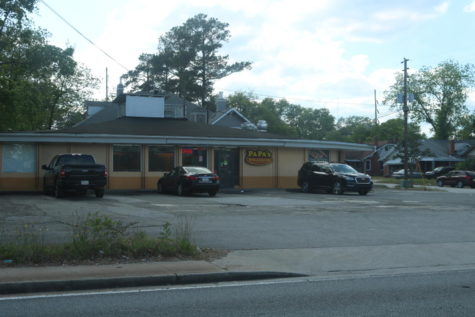
Food deserts do have access to food; however, the food is often fast food chains, said David Davis, who is . Associate Director of the Spencer B. King Jr., Center for Southern Studies.
“There’s enough food to maintain the biological processes of life,” Davis said. “But it’s not the type of nutritionally dense food that will be considered the foundation of a healthy diet.”
These deserts, Davis said, highlight characteristics of poverty found in cities like Macon.
“Neighborhoods with these characteristics are likely to have shorter average lifespans, significantly less economic mobility, less academic achievement, significantly higher crime rates, and higher rates of teen pregnancy,” Davis said.
Lack of access to food, healthy food in particular, also hinders childhood development. This makes it harder for kids to focus and also impacts students’ educational success, Cooke said.
“A lot of people don’t recognize that healthy food options have a role in behavioral outcomes, long term outcomes for people, and it affects your mental health care,” Cooke said. “What you put in your body affects you overall.”
Cooke said that she saw the link through working with children in different environments and through feeding her own children and seeing their behavioral changes.
“because I’m just naturally curious, and because I’m a researcher — I just started researching the connection between certain foods and behavioral health outcomes,” she said.

Cooke began to feed her children differently, and she started to see a difference in their behavior. But, according to Cooke and various studies, these health impacts are wide-ranging and extend past physical health.
“Oftentimes people think about health outcomes. And health outcomes don’t just involve physical health. It also involves mental health,” Cooke said. “The food desert issue is a mental health issue.”
According to a study in The Journal of Nutrition, household food insecurity is associated with mental disorders among children and adolescents in the United States, and improving this could decrease mental disorders among U.S. youth.
“There are a lot of uncomfortable conversations because a lot of times people don’t think that a mental health professional should have a say in the food desert conversation. And I just happen to believe that we all have a say,” Cooke said.
But Cooke said being a food desert hurts the community itself, too.
“What I’ve seen, specifically in my community, is people moving,” Cooke said. “Food deserts do create blight because people leave — people leave because they don’t have easy access to food.”
Seeing this happen in a neighborhood like Napier Heights is disheartening to Cooke.
“Napier Heights heights is a historic community,” Cooke said. “Most of the houses in our neighborhood are over 100 years old. They have character, and the people who live in them have character. They deserve to have healthy food options.”
To show the effects firsthand, the United Ministries of Durham created SPENT, which is a poverty simulation that demonstrates the experience that low-income households face.
How does transportation factor in?
In 2018, reporters from The Telegraph and Georgia Public Broadcasting tried to see how the closing of the Kroger has changed access to food in the area around it.
The nearest place where they could purchase a list of grocery staples — bread, milk, egg, chicken, bananas, apples, carrots, lettuce, beans, cereal, peanut butter and jelly — was the My Store on Pio Nono avenue. That is a 1.5 mile walk from the site of the Kroger and was $6 more expensive than Kroger.
But many people still go to the nearest Kroger for their groceries, Cooke said, with the nearest shops being located in North and East Macon. That’s miles away from their neighborhood, making the trip to the grocery store more difficult, she said.
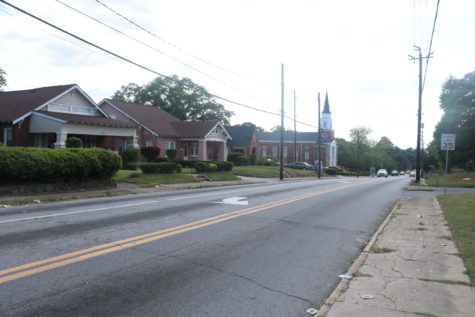
Pio Nono Ave. is the home to one of Macon’s food deserts in the Napier Heights neighborhood. Residents and social advocates like Andrea Cooke cite a lack of transportation and accessible grocery stores in this area as one of the underlying causes of widespread food insecurity. (Photo by McKenna Kaufman)
Because of the increase in distance, some people have changed how they get to their groceries. Davis explained that people often go to great lengths to get food.
“We also see an awful lot of people who may call an Uber or a Lyft, to take them back and forth from the grocery store, but that’s how it remains,” Davis said. “They’re paying a surcharge, effectively an additional tax to get access to additional food. This is one of many examples that, in the United States, it’s expensive to be poor.”
Davis also indicated that the Macon bus system, or the Macon Transit Authority (MTA), has had its issues in recent years.
“In the economic downturn of 2008, the city of Macon has fewer resources to invest in MTA bus system and Macon communities,” Davis said.
For those without cars, some people in Napier Heights take a four-hour bus trip to get to the nearest grocery store to get food, Cooke said. This makes the trip to the grocery store a greater time investment.

A map of Macon Transit Authority Bus Routes in Macon-Bibb County. (Infographic by Phoebe Monsour. Source: Macon-Bibb County Transit Authority, 2020.)
A study from the University of Wisconsin found that transportation is linked to the “nature and identity of food deserts.”
“The method people use to get to the grocery store is an extremely important aspect of the quantity, quality and price of healthy food they have access to,” the researchers said.
In addition to the money spent to take the time-inefficient trip, healthy food is more expensive on average than heavily processed food sold elsewhere. With that processed food being much more available in the community, that’s what some people in Napier Heights turn to, Cooke said.
“They go to convenience stores. They go to those small Dollar General-type, Family Dollar stores,” Cooke said. “And if you’ve ever been into one of them, you quickly realize that there’s heavily processed food and frozen food and no fresh food in those places. So that’s what we’re left with.”
What is the history?
At the Washington Memorial Library archives, Macon’s city directories between the years 1930 and 2005 show that the number of locally owned grocery stores in Macon decreased to make room for supermarket chains that opened in the late 20th centuries.
Grocery store chains like Kroger are typically able to sell food cheaper than independent grocery stores.
According to the Dayton Daily News from Dayton, Ohio, because those chains have so many stores and buy so much food, they are able to negotiate lower prices from sellers. That allows those grocery store chains to undercut local competitors which often drives those local players out of business.
But when these corporate supermarkets decide to close due to declining sales, like what occurred with the Kroger on Pio Nono, there are no longer enough locally owned and operated grocery stores to sustain the communities who came to rely on the supermarket chains.
This contributes to the ongoing food insecurity issue in Macon and the widespread existence of food deserts.
The Washington Memorial Library preserves decades worth of Macon’s city directories that detail the shift the city made over time from locally-owned grocery stores to larger supermarket chains like Kroger that later limited residents’ access to healthy food options. (Photo by McKenna Kaufman)
As of 2000, studies conducted assessing Macon’s racial and economic demographics found that Black citizens were four times more likely to live in poverty than their white counterparts, according to Andrew M. Manis in his book Macon Black and White.
“There’s a generational debt that’s being paid by our lack of investment in those communities during the Great Depression that continues to manifest today,” Davis said.
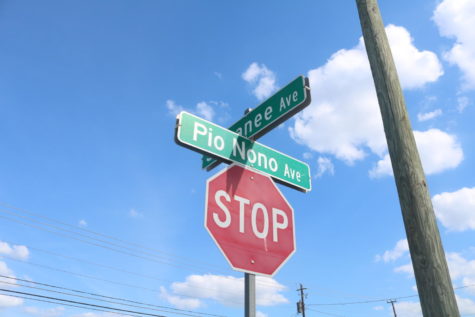
Macon has historically been divided along racial lines that have roots in the Jim Crow era, as Manis’ book outlines, with these divisions becoming continuously more apparent. Those racial lines also often align with a community’s ability to access food and their access to economic resources.
Poverty impacts communities’ employment, transit and economic opportunities, thus contributing to the food desert issue that has been exacerbated by a lack of locally-owned and accessible grocery stores and corporate decisions to close supermarket chains.
“Even though redlining supposedly came to an end with the Fair Housing Act of 1968, we find that it still directly affects housing values, neighborhood incomes, access to quality education — and access to nutritionally dense food,” Davis said.
How can we help and what does this mean for the future?
The Napier Heights Food Co-op is a community-based organization with the goal of bringing affordable healthy food options within walking distance of the Napier Heights community.
“You feel more connected to a place that’s connected to you, that sees you, that values you, that wants to hear your input,” Cooke said. “Our Co-op will be run by the community.”
A food co-op is a community-owned grocery store, and the store’s customers, also known as members, are also the store’s owners.
Shoppers have to pay a small fee or volunteer at the co-op in order to become members, Cooke said. While anyone in Macon can become members, only those from Napier Heights will have voting power in the co-op, making the decision about how the co-op is run.
“We really want this to be something that is driven, run and owned by the people who it will be serving,” Cooke said.
The people who fill the jobs — cashiers, stockers, people who work in the garden — will all be members of the community, and the Co-op hopes to pay them, Cooke said.
“There are a few of us who are spearheading this project. But it doesn’t belong to us. It belongs to the Napier Heights community, and I’m hopeful that this will be something that is echoed throughout other smaller neighborhoods in Macon,” Cooke said.
Cooke said another goal of the Co-op is to hold classes to teach people about different fruits and vegetables and how to prepare food in a healthy way without using some of the spices and foods that create additional health disparities.
The co-op also intends to educate people via social media and by partnering with the neighborhood association.
“There are certain people who have never even tried asparagus. There are people who haven’t opened up to the vast array of potential food choices,” Cooke said. “So we want to also have opportunities for people to come and try foods that they’ve never tried before.”
In addition to food co-ops, Cooke said there should be more conversation about food deserts and penalties for corporate entities leaving neighborhoods without sufficient food options.
“I think that corporate responsibility is important. You know, corporations represent people,” Cooke said. “So we have to begin to hold people accountable. It is important for us to take care of the least of us. And if you’re not willing to do that, then maybe that’s not an organization that should be in our community.”
The Center for Collaborative Journalism reached out to Kroger’s Atlanta media division — which covers all of Georgia and some other states in the South — but did not hear back by deadline.
Davis said that the closing of the Kroger on Pio Nono has served as a flashpoint in the conversation on food access in Macon, but he suggests that, even though the discussion has been important, there is one barometer of progress where little movement has been made.
“When we actually get to a point of building a grocery store in Bloomfield, then we’re making huge progress,” Davis said. “When we have a grocery store in Pleasant Hill, then we’re making progress. When we’re putting the nutritional access in the old Kroger store on Pio Nono, then we’re making progress.”





